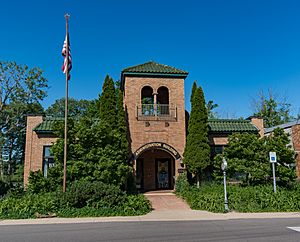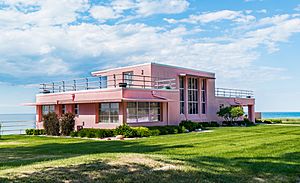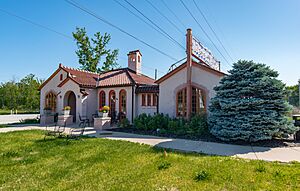Beverly Shores, Indiana facts for kids
Quick facts for kids
Beverly Shores, Indiana
|
|
|---|---|
| Town of Beverly Shores | |

|
|
| Country | United States |
| State | Indiana |
| County | Porter |
| Township | Pine |
| Government | |
| • Type | Town Council |
| Area | |
| • Total | 5.83 sq mi (15.09 km2) |
| • Land | 3.58 sq mi (9.28 km2) |
| • Water | 2.25 sq mi (5.81 km2) |
| Elevation | 604 ft (184 m) |
| Population
(2020)
|
|
| • Total | 599 |
| • Density | 167.18/sq mi (64.54/km2) |
| Time zone | UTC-6 (CST) |
| • Summer (DST) | UTC-5 (CDT) |
| ZIP code |
46301
|
| Area code(s) | 219 |
| FIPS code | 18-05158 |
| GNIS feature ID | 2396590 |
Beverly Shores is a small town in Indiana, located near the beautiful Lake Michigan shoreline. It's about 36 miles (58 km) east of Chicago. In 2020, about 599 people lived here.
Contents
History of Beverly Shores
Beverly Shores started as a special vacation spot. In the early 1900s, a train line called the Chicago, Lake Shore & South Bend Railway helped people travel from South Bend to Chicago. In 1925, a businessman named Samuel Insull improved the train line, now called the South Shore Line. He made the stations better and encouraged people to visit the area.
In 1927, the Frederick H. Bartlett Company, a big real estate company from Chicago, bought a large area of land. They planned to build thousands of homes. But then the Great Depression happened, which slowed down their plans. Many of the plots were never built on.
Developing the Town
In 1933, Robert Bartlett, Frederick Bartlett's brother, bought the land. He named the whole area "Beverly" after his daughter. He continued to build up the town, adding roads, a school, a golf course, and a hotel.
He also bought sixteen buildings from Chicago's 1933-34 Century of Progress World's Fair. Four of these buildings were brought to Beverly Shores by barges across Lake Michigan! These unique homes are now part of the Century of Progress Architectural District.


Becoming a Town and Protecting Nature
Beverly Shores officially became a town in 1947. After World War II, some industrial areas were built nearby. By the 1950s, people started to worry about protecting the natural beauty of the area.
In 1966, the Indiana Dunes National Lakeshore was created to protect the land. There was a plan in the 1970s to buy all the homes in Beverly Shores and make the whole town part of the National Lakeshore. This didn't happen, but many properties, especially in the wetlands, were bought for the park. This process is still ongoing today.
During the 1970s, the lake levels were very high, and the beach started to wear away. Some homeowners put large concrete blocks on the sand to protect their houses. Today, the beach is open to everyone, but parking nearby is limited.
Recent Changes and Community Life
In the 1990s and 2000s, many new, expensive houses were built on the sand dunes near the lake. Around 2000, the town improved its water supply by connecting to pipelines that bring treated water from Michigan City.
In 1998, the Spanish Colonial Revival train depot, built in 1929, was beautifully restored and reopened. It now has a museum with old photos and items, and a gallery showing local art.
Beverly Shores is easy to reach from Chicago. Many people from Chicago have second homes here and are sometimes called "some-timers." Both full-time and part-time residents enjoy community events. These include ice skating during Winterfest, the 5k Necktie Race on Father's Day, and the Fireman's Ball, which raises money for the volunteer fire department.
Beverly Shores is known for being a welcoming community and a place where many artists live.
Exploring Beverly Shores
Beverly Shores attracts many visitors, especially nature lovers, cyclists, and bird watchers. They come to enjoy the beautiful beaches and marshlands. If you want to stay overnight, you can reserve a campsite at Dunewood Camp.
In 2014, Beverly Shores was named the world's seventh "International Dark Sky Community." This means the town works to reduce light pollution, making it a great place to see stars at night!
Geography and Nature
Beverly Shores is located right along the Lake Michigan shoreline. It is next to the Indiana Dunes National Park. The town was first planned as a resort community for people from Chicago.
Six places in Beverly Shores are listed on the National Register of Historic Places. This includes a group of six buildings that were moved by barge from the 1933 Century of Progress World's Fair in Chicago. This area is called the Century of Progress Architectural District.
Beverly Shores is bordered by Indiana Dunes State Park to the west, Lake Michigan to the north, the village of Pines to the south, and Michigan City to the east. A large part of the area around Beverly Shores is part of the Indiana Dunes National Park.
The town covers about 5.82 square miles (15.07 km2). About 3.58 square miles (9.27 km2) of this is land, and 2.24 square miles (5.80 km2) is water.
Population Facts
| Historical population | |||
|---|---|---|---|
| Census | Pop. | %± | |
| 1950 | 488 | — | |
| 1960 | 773 | 58.4% | |
| 1970 | 946 | 22.4% | |
| 1980 | 864 | −8.7% | |
| 1990 | 622 | −28.0% | |
| 2000 | 708 | 13.8% | |
| 2010 | 613 | −13.4% | |
| 2020 | 599 | −2.3% | |
| U.S. Decennial Census | |||
Who Lives in Beverly Shores?
According to the 2010 census, there were 613 people living in Beverly Shores. Most residents were White (96.6%). A small number were African American (1.3%), Asian (0.3%), or from other backgrounds. About 2.8% of the population was Hispanic or Latino.
There were 312 households in the town. About 12.8% of these households had children under 18. Many households (54.8%) were married couples living together. The average household had about 1.96 people.
The average age in Beverly Shores was 59 years old. About 9.8% of residents were under 18, and 34.1% were 65 or older. The town had a nearly equal number of males (50.2%) and females (49.8%).
Schools in the Area
Students in Beverly Shores attend schools that are part of the Michigan City Area Schools district. The elementary school for this area is Pine Elementary School. Students then go to Barker Middle School. For high school, students attend Michigan City High School.
Important Landmarks
Here are some important buildings and areas in Beverly Shores that are listed on the National Register of Historic Places:
- The Bartlett Real Estate Office, also known as the Beverly Shores Administration Building.
- The Beverly Shores South Shore Railroad Station, a historic train station built in 1929.
- The Century of Progress Architectural District, which includes the special World's Fair Houses.
- The Imre and Maria Horner House, designed by Otto Kolb.
- The Dr. John and Gerda Meyer House, built in 1961.
- Solomon Enclave.
See also
 In Spanish: Beverly Shores (Indiana) para niños
In Spanish: Beverly Shores (Indiana) para niños

